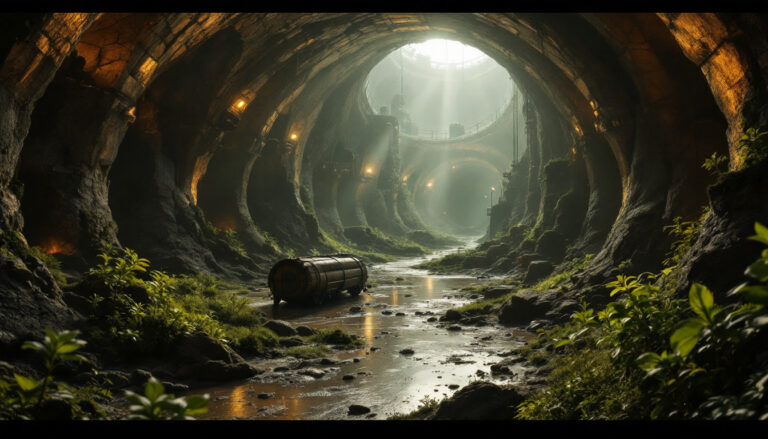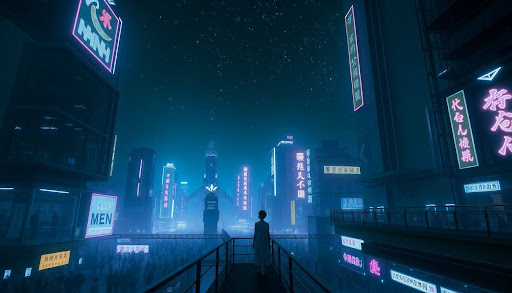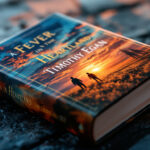Dust by Hugh Howey – A Thoughtful Review of the Silo Series Finale
The Silo series has captivated readers with its gripping portrayal of a world confined underground. In Dust, the final book in Hugh Howey’s trilogy, we see the culmination of secrets, struggles, and humanity’s longing for freedom. Fans of dystopian stories will find themselves on the edge of their seats as the threads from Wool and Shift come together. Is this the resolution readers have been waiting for? Let’s take a closer look.
Overview of the Silo Series
Hugh Howey’s Silo Series is a gripping exploration of human resilience, control, and the pursuit of truth. Set in a grim, post-apocalyptic world, it invites readers to imagine life confined within the walls of a massive underground silo. Across three books—Wool, Shift, and Dust—Howey carefully crafts a narrative of survival and rebellion that keeps readers hooked from start to finish. Let’s break down the core of what makes this series so compelling.
What is the Silo Series About?
At its core, the Silo Series presents a chilling dystopian vision: humanity forced to live underground in a vast silo structure, isolated from a toxic world above. Each silo is an enclosed society, cut off from others and strictly governed by rules designed to maintain balance and order. Outside, the air is poisonous, and the surface is a barren wasteland—or so the people are led to believe.
The story begins in Wool, where we meet Silos residents navigating their day-to-day lives under the watchful eyes of their leaders. As the series progresses, cracks appear in the carefully constructed system. Why were these silos built? What lies beyond their walls? These questions, whispered at first, unravel a complex web of secrets that drive the trilogy forward. The setting itself is a character: dark, oppressive, but also a symbol of both protection and imprisonment.
Themes Across the Series
The Silo Series is more than just a story about people surviving underground—it’s a deep dive into human nature and the systems we create to survive. Hugh Howey weaves several powerful themes throughout the books:
- Survival vs. Freedom: The series constantly asks, “What are we willing to trade for safety?” Residents inside the silo live because of strict rules, but that security comes at a cost: freedom.
- The Balance of Power: From the silo’s leadership to ordinary people questioning authority, the story highlights the tension between maintaining order and suppressing individual thought.
- Community and Isolation: The silos are microcosms, complete with their own hierarchies and cultures. While some characters yearn for connection, others succumb to the loneliness and claustrophobia of silo life.
By addressing these themes head-on, the books keep readers questioning every decision the characters make and every revelation about their world.
Hugh Howey’s Writing Style
Hugh Howey’s storytelling is what truly brings the Silo Series to life. His writing is direct and unpretentious, yet he wields suspense and tension with precision. The narrative alternates between multiple perspectives, giving readers an intimate look at the thoughts, fears, and motivations of various characters.
This approach not only builds depth but also ensures that no piece of the puzzle is revealed too soon. Howey knows exactly when to drop hints and when to hold back, which makes his books hard to put down. He doesn’t overwhelm readers with excessive descriptions, but every detail he includes serves a purpose, painting vivid images of both the silo’s interior and the bleak world outside.
By the time you dive into Dust, the culmination of his careful plotting comes to light, and the stakes feel higher than ever. If anything, Howey’s style is a reminder that great storytelling isn’t about flashy tricks—it’s about creating characters and conflicts that feel real and urgent.
Plot Summary of Dust (Spoiler-Free)
Hugh Howey’s Dust serves as the explosive conclusion to his Silo Series, bringing together the storylines and questions left lingering from Wool and Shift. This final installment focuses on survival, identity, and the unyielding quest for truth. The backdrop of a confined, crumbling society makes every decision the characters face feel urgent and deeply human. As tensions rise and secrets emerge, the future of the silos—and what lies beyond—balances on a knife’s edge.
Readers will find Dust darker, faster-paced, and brimming with moral dilemmas. It’s not just a race against external dangers but also a battle against the limits of what people can endure. Howey doesn’t pull back on exploring whether it’s the systems we build or the people who defy them that truly shape the future. This is the silo at its breaking point.
The Stakes in Dust
If there’s one thing that sets Dust apart from its predecessors, it’s the heightened tension. Where Wool was intimate and mysterious, and Shift was expansive in unraveling histories, Dust catapults readers into the story’s final act. Now, every question isn’t just about survival—it’s about the decisions that will define humanity’s fate. For characters who’ve grown within an oppressive structure, the question isn’t just “can we save ourselves?” but also, “is it worth saving?”
This book feels bigger—not in geography, but in consequence. While previous installments focused on the discovery of secrets, Dust places those secrets under a harsh spotlight. Right and wrong blur, and every choice carries rippling effects. The silos themselves, once symbols of preservation, now seem like prisons or powder kegs ready to erupt.
If you’ve ever read a series waiting for that heart-stopping, edge-of-your-seat moment where everything comes to a head, Dust delivers. It’s a testament to the series’ buildup, where every layer of the story contributes to this final crescendo.
Key Characters in Dust
The characters in Dust ground the story with their humanity. No matter how dire the circumstances, it’s their motivations, flaws, and courage that give the story its weight. While there’s a larger ensemble, a few key figures stand out. Don’t worry, we’ll avoid spoilers—but let’s meet them at a glance:
- Juliette Nichols: Serving as a central figure since Wool, Juliette is a beacon of resilience. Her defiance of the silo’s rules and her hunger for truth continues to drive the narrative. She’s flawed, headstrong, and fiercely loyal, making her both admirable and relatable. In Dust, we see her take on even greater responsibility as the stakes around her escalate.
- Donald Keene: Introduced in Shift, Donald bridges the past and present of the silo system. His character wrestles with guilt, choices, and the weight of knowledge. In Dust, his role becomes even more critical, especially as revelations about the silos unfold. His story brings a reflective, moral angle to the fast-paced narrative.
- Solo and the Children: Solo (Jimmy) and the orphaned children bring a layer of innocence and hope to an otherwise harsh world. They remind readers what’s at stake and provide a counterbalance to the darker elements of the story. Their struggle to survive mirrors humanity’s broader desire for connection and future-building.
These characters—and others, like Lukas or the secondary figures working behind the scenes—each embody different facets of humanity. Howey uses them to explore themes of leadership, sacrifice, and the choices that separate survival from living.
What makes them shine is how Dust never seeks to paint anyone as fully good or bad. Instead, it shows people grappling with impossible situations, doing their best to make sense of it all. You’ll root for them, doubt them, and, at times, wish you could warn them about what’s around the corner.
Major Themes in Dust
Dust isn’t just the conclusion of a story—it’s a layered examination of what drives people, communities, and societies to thrive or collapse. Through its tense and emotional narrative, the book tackles themes that resonate deeply with questions about power, humanity, and what it means to endure. Let’s take a closer look at how these ideas play out in the story.
Power and Corruption
One of the most striking aspects of Dust is its portrayal of power—who holds it, how it’s wielded, and the consequences when it’s abused. The silo system, by design, is a controlled environment where leaders maintain strict order to prevent chaos. Over the course of the series, this system is revealed to be far from altruistic. In Dust, the rot at the core of these power structures is exposed in full.
Through the lens of characters like Juliette, Donald, and others, readers see the devastating impact of unchecked authority. Leaders often justify their decisions with the belief they’re maintaining stability, but what happens when stability comes at the cost of truth and freedom? This theme feels uncomfortably familiar in our world, where power frequently corrupts those who hold too much of it for too long.
The silo’s leadership, veiled in secrecy and manipulation, is a clear example of how power disconnects rulers from the ruled. Those in charge view the people they govern as assets to be managed, rather than individuals with autonomy. At the same time, we’re reminded that power doesn’t only corrupt systems—it tempts individuals. The decisions certain characters face put their morality to the test, asking whether doing what’s “necessary” is the same as doing what’s right.
It’s a stark, thought-provoking portrayal of what can happen when control isn’t questioned. And yet, resistance exists, hinting at something stronger beneath the surface.
Hope and Humanity
Amid the bleakness of Dust, moments of hope shine like small but persistent flames. The silo’s walls are suffocating in both a physical and emotional sense, but even in this sealed-off world, characters refuse to let despair take over completely. These moments remind readers of the strength that comes from human connection and empathy.
Take Juliette, for instance. Her actions—whether fueled by anger or determination—are rooted in a belief that people deserve to know the truth, no matter the personal cost. She refuses to accept that the silos are the end of the story. Her drive sparks others to look beyond their immediate suffering and imagine something more.
Then there’s the character of Solo, who embodies the resilience of the human spirit. Despite years of isolation, he holds onto remnants of humanity, caring for the children and creating a small, fragile community. It’s this emphasis on connection, however tenuous, that keeps hope alive in readers’ minds. Even in the direst moments, there’s a sense that kindness and compassion might outlast the systems designed to suppress them.
The beauty of Dust lies in its ability to make you wonder: How far would you go to care for someone else? To protect a sliver of hope in a broken world? These small acts of humanity might not change the silo overnight, but they’re undeniable proof that people are more than just cogs in a machine.
Legacy and Survival
The theme of legacy looms large throughout Dust. It’s the foundation of the silos themselves—built on the idea of preserving humanity at all costs. But the book challenges readers to think about what kind of world is worth preserving. Is survival alone enough, or should survival pave the way for something better?
For characters like Donald, the question of legacy becomes deeply personal. He’s not just grappling with the physical silos but also the moral implications of his role in building them. Through his internal struggle, the book explores a larger idea: What do we leave behind, and how will it define us? For some, legacy is tied to good intentions; for others, it’s a haunting reminder of compromises made along the way.
The people of the silos are, in essence, living monuments to survival. Yet, the cost of this survival often feels unbearably steep. As Dust progresses, we see characters question whether they’re holding onto life for its own sake or fighting for a chance to truly live.
This theme feels especially poignant during scenes where the future of the silos is on the line. Will the characters choose to protect their past or risk everything for an unknown but freer future? These questions hit close to home for anyone who’s ever wondered about the trade-offs humanity makes in its quest to endure.
In the end, Dust presents survival not as a passive state but as a choice—a balancing act between preserving what’s familiar and daring to create something new. It’s this tension that gives the series its emotional weight and keeps readers invested in the characters’ journeys.
Strengths of Dust
Hugh Howey’s Dust is not just the conclusion to a trilogy—it’s the payoff for readers who’ve followed the story from the confined halls of the silos to the uncertain possibilities of the surface. This final book brings everything together with purpose, wrapping up the series in a way that feels earned and deeply satisfying.
A Fitting End to the Series
One of Dust‘s greatest strengths lies in how it resolves lingering questions from Wool and Shift. Loose ends that might have been forgotten are carefully addressed, showing Howey’s commitment to his story and readers. Every major storyline converges in a way that doesn’t rely on convenience or forced explanations. Instead, it feels like the natural result of the tensions and conflicts that have been building since the very beginning.
The book also highlights the series’ core message: the tension between survival and freedom. Characters who’ve endured unthinkable challenges are finally given moments of clarity, even as they continue to grapple with the choices ahead of them. Howey doesn’t offer easy solutions, but he does provide closure where it matters. Readers are left with the sense that this is how the story was meant to end—bittersweet but satisfying.
For fans who worried about how such a complex series could stick the landing, Dust proves that Howey had a plan all along. It’s not flashy or overdone; instead, it’s grounded and true to the story he set out to tell.
Pacing and Suspense
Howey knows how to keep readers hooked without overwhelming them. Dust strikes a perfect balance between moments of quiet reflection and bursts of heart-pounding tension. The pacing feels deliberate, like a well-tuned piece of machinery, ticking along and pulling readers deeper into the story with every chapter.
The stakes in this book feel enormous, and not just because it’s the last in the series. Every chapter edges closer to a conclusion that feels both inevitable and unpredictable. Just when you think you know what’s coming, Howey finds ways to surprise you—not with cheap twists but with smart, thoughtful storytelling. The suspense is relentless, but it’s never overdone. Each moment has weight, making it hard to stop reading.
Howey’s ability to create tension resembles the slow build-up of a storm. He lets you feel the unease before hitting you with the full force of the conflict, keeping you engaged from start to finish. Whether it’s through the dangerous circumstances the characters face, the difficult moral choices they make, or the unraveling of the silos’ darkest secrets, you’re always on edge in the best possible way.
Character Development
The characters in Dust feel as real and layered as they’ve ever been. Howey clearly took the time to ensure each person’s growth felt natural, and it shows. Readers who’ve followed these characters since Wool or Shift will appreciate how far they’ve come—both in their personal journeys and relationships with others.
- Juliette remains one of the trilogy’s shining stars. Her defiance, independence, and drive to uncover the truth have made her a character worth rooting for since the start. In Dust, we see her step into an even larger role, battling not only external threats but also her own doubts and limitations. She feels more human here than ever before—flawed but fiercely determined.
- Donald, introduced in Shift, takes on a more central role in this installment. His perspective, shaped by guilt and regret, adds a sense of gravity to the story. He serves as a reminder that even those who played a role in creating tragedy can seek redemption, but not without immense inner struggle.
- Side characters like Lukas, Solo, and the children bring added layers to the story. Lukas, who’s long held onto his hope for a better future, represents the quiet resilience of the silos’ people. Solo and the children, meanwhile, ground the story in its emotional core—they show what’s truly at stake and why the fight for freedom matters.
What’s remarkable is how every character feels necessary to the story. Even secondary figures contribute something meaningful, whether it’s insight, tension, or emotional weight. Howey doesn’t waste space on filler personalities; everyone in Dust has a role to play, and they play it well.
By the end of the book, you don’t just feel like you’ve read about these people—you feel like you’ve lived alongside them, sharing in their fears, hopes, and triumphs. That’s the true strength of the series: its human heart.
Critiques of Dust
While Dust brings the Silo Series to an emotional and fitting conclusion, it’s not without elements that might divide readers. As much as the book excels in delivering a high-stakes finale, some aspects could leave certain fans feeling frustrated or disconnected. Let’s explore a few areas where the story may stumble for some.
Complexity of the Plot
The plot of Dust is undeniably rich with connections, revelations, and moving pieces, but for some readers, this depth could feel like a double-edged sword. The narrative weaves between past and present, multiple characters, and interconnected storylines—all while tying up threads from the previous two books. To seasoned fans of the series, this level of detail might feel rewarding. However, newer or more casual readers could find it overwhelming.
There are moments where the sheer amount of information can feel like drinking from a firehose. If you don’t clearly remember the events of Wool or Shift, some details might lose their impact. The pacing of revelations also adds to this complexity. While Dust effectively balances slower emotional moments with fast-paced action, the number of critical plot points coming to light in a short span could blur the bigger picture for some.
For readers who thrive on tightly packed narratives, this won’t be an issue. But others might find themselves re-reading sections or reaching for summaries of earlier volumes to keep track of everything. Does it affect the story’s power? Not necessarily—but it does require patience and focus.
Pacing in Certain Sections
While Dust mostly keeps readers engaged with its relentless tension, some parts of the book don’t sustain the same momentum. There are chapters where the pacing slows down, particularly when characters pause to reflect, strategize, or dig into the silo’s history. For some, this will feel like a welcome breather after intense sequences; for others, it might feel like the story is dragging its feet.
Take, for example, the sections where characters discuss morality or the implications of their choices. While these moments are critical for character development and theme-building, they can feel drawn out compared to the higher-stakes scenes around them. If you’re someone who prefers a consistently fast narrative, these stretches might pull you out of the story’s flow.
Similarly, the book leans heavily on introspection at times, particularly with Donald’s storyline as he wrestles with guilt and legacy. While this adds depth, it can feel repetitive in places—especially for readers looking to move forward in the overarching plot. Some may find themselves eager to skim these slower moments to get back to action or unraveling mysteries.
In the end, the pacing issues aren’t glaring, but they could impact how much momentum some readers feel when moving through the story. If you enjoy a mix of action and reflection, you’ll likely appreciate the balance. If not, these sections might test your patience.
Who Should Read Dust?
If you’re wondering whether Hugh Howey’s Dust is the right read for you, the answer might depend on what you love in a story. Dust, being the final installment of the Silo Series, has something for multiple types of readers. Whether you’re a fan of dystopian worlds, someone considering jumping into the series for the first time, or a lover of books that challenge your thoughts, this section will help you decide if it’s your kind of book.
Fans of Dystopian Fiction
If you’re drawn to stories set in grim, tightly controlled worlds where humanity’s survival is at stake, Dust is a must-read. The Silo Series as a whole offers a fresh take on the dystopian genre—there are no overused tropes or generic heroes here. Instead, Howey builds a world where every moment feels claustrophobic, and every choice has weight.
Readers who enjoyed the tension of The Hunger Games or the layered control systems in 1984 will likely find Dust exhilarating. It’s not just about characters versus the system; it digs deeper into questions of whether society’s rules help or harm us. The silos themselves are the perfect metaphor for the balance between safety and freedom. Unlike some dystopian books that focus solely on rebellion, Dust explores the emotional and moral costs of challenging a system built to protect and control.
What makes Dust really special for fans of dystopia, though, is the way Howey keeps pushing the boundaries. Just when you think you know how life in the silo works, he pulls back another layer of the mystery. If you love peeling back the layers of a broken world to get to its heart, this book won’t let you down.
New Readers to the Series
Thinking of just jumping into Dust without reading Wool or Shift? While it may be tempting to dive straight into the series finale, you’d be doing yourself a disservice. Dust is not a standalone novel—it’s the payoff for two other books that set the stage and build the stakes.
New readers should start with Wool, the first book in the series. It introduces the silo’s isolated, underground world and allows you to understand the rules and the people confined within them. Shift, the second book, dives into the history behind how the silos came to be, offering crucial backstory that deeply enriches the events of Dust. Without these two books, you might miss the emotional resonance and the layered relationships that drive the story forward.
But don’t let that intimidate you. The series is highly readable, with Howey’s straightforward style making even complex ideas easy to grasp. By starting from the beginning, you’ll not only enjoy Dust more, you’ll have a much deeper appreciation for the world Howey has created. Trust me—this is a series worth experiencing in full.
Those Interested in Thought-Provoking Themes
Do you like books that linger in your thoughts long after you turn the last page? Then Dust is for you. It’s more than just a dystopian thriller; it’s a book that takes aim at some of life’s biggest questions. It examines the systems we live under and forces you to ask: Are they keeping us safe, or holding us back?
Throughout the series, Howey tackles themes like power, truth, control, and survival. In Dust, these ideas come to a head. What happens when people fight for freedom after generations of being told they can’t live without the rules? Howey doesn’t spoon-feed answers —instead, he leaves space for readers to wrestle with these questions themselves.
If you’ve ever found yourself pondering the way technology, governments, or even social norms shape our world, you’ll find parallels between Howey’s silos and the systems we navigate in real life. Dust isn’t just a story of survival; it’s a layered exploration of what it means to truly live.
For readers who love the philosophical undertones of books like The Road or Station Eleven, this series aligns perfectly. While Dust keeps the tension high with its plot, it never loses sight of these deeper themes. If you enjoy stories that make you feel and think in equal measure, this finale will leave a lasting impression.
Where to Get Dust
So, you’re ready to experience the thrilling conclusion of Hugh Howey’s Silo Series and want to know where to find Dust. The good news? It’s widely available, from traditional retailers to digital platforms. Whether you prefer a good old-fashioned paperback, an eBook, or an audiobook you can enjoy on the go, you’ve got plenty of options. Let’s break it down.
Online Retailers
Shopping online is probably the quickest way to get your hands on Dust. You can order a physical copy or download it instantly in digital format. Here are some popular sites where you’ll find it:
- Amazon: Available in paperback, hardback, Kindle, and audiobook formats. It’s often discounted, and if you’re a Prime member, you’ll probably snag free shipping.
- Barnes & Noble: Offers paperback, Nook eBook, and even collectible editions if you’re a fan of special covers. You can also check if your local store has it in stock for same-day pickup.
- Books-A-Million (BAM): Another great option for hard copies and digital formats. They occasionally run promotions, so it’s worth checking for deals.
- Apple Books: If you’re an iPhone or iPad user, head over to their store for a seamless eBook purchase.
Most of these platforms also provide customer reviews, so you can see what other readers think before you hit that buy button.
Local Bookstores
Prefer to support small businesses? Local bookstores often carry Dust, especially if Wool and Shift are already on their shelves. Independent shops might even have staff-written recommendation cards pointing out why they love this series.
If you’re unsure whether your favorite local store has it in stock, call ahead or check their website. Many indie shops also partner with services like Bookshop.org, which allows you to order online while supporting independent bookstores. It’s a win-win.
Libraries
If you’re on a budget or just love the feel of a library book in your hands, head to your local library. Many libraries carry Dust, and if it’s not on the shelf, you can often request it through their interlibrary loan program. Better yet, many libraries now offer access to eBooks and audiobooks through apps like Libby or OverDrive, so you may not even have to leave the couch.
Audiobook Platforms
Want to listen to the story unfold during your commute or while doing chores? Audiobooks are a fantastic option, and Dust is available on several platforms:
- Audible: Hugh Howey’s Silo Series is well-regarded in audiobook format, with strong narration that pulls you right into the story. Audible offers a free trial if you’re a new user, so you could potentially listen to Dust without spending a dime.
- Google Play Books: If you’re an Android user, this is a hassle-free way to buy and listen.
- Kobo Audiobooks: Another solid option, especially if you’re already using Kobo for eBooks.
Audiobooks are great for readers who multitask or have busy schedules. With professional narration, the tension and emotion of Dust come alive in a whole new way.
Secondhand Bookstores and Exchange Platforms
If you’re trying to save money or enjoy the idea of giving a book a second life, secondhand bookstores are worth checking out. Sites like ThriftBooks and Better World Books often carry used copies in excellent condition. Many local used bookstores may also have Dust for a fraction of the price.
For a more community-driven approach, check out book exchange apps like PangoBooks or BookMooch, where readers trade books they’ve already finished. Who knows? You might find a whole new reading community to connect with.
Digital Subscription Services
Are you subscribed to a reading platform? Services like Kindle Unlimited or Scribd sometimes offer Dust as part of their catalog. If you already pay for these, it’s worth checking before buying a separate copy. Even if it’s not free with your subscription, these platforms often discount eBooks.
The bottom line is that Dust is within easy reach no matter your reading preference or budget. Whether you grab it from an online retailer, swipe it from your local library, or download the audiobook, this finale to the Silo Series deserves a place on your reading list. Ready to find out what happens beyond the silo walls? Grab your copy today and start reading!
Conclusion
Hugh Howey’s Dust delivers a bold, emotional, and satisfying conclusion to the Silo Series. It’s a story that sticks with you, blending heart-pounding tension with deeply human themes. From the moral complexity of its characters to the thought-provoking exploration of survival and freedom, this book does more than close a trilogy—it leaves a lasting impression.
Whether you’re already a fan of the series or love dystopian stories packed with meaning, Dust is a must-read. It’s the kind of book that sparks conversation and makes you question what kind of world is worth fighting for.
Have you read Dust or the rest of the Silo Series? Share your thoughts or let us know what resonated with you. And if you haven’t started the series yet, now is the perfect time to dive in—you won’t regret it.







